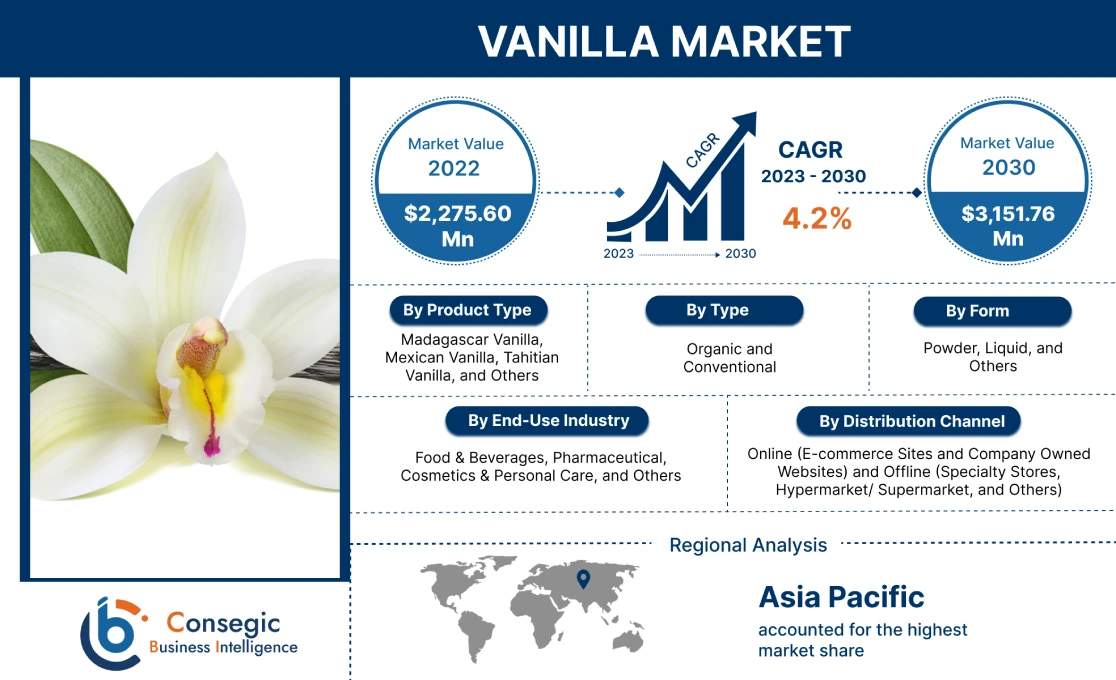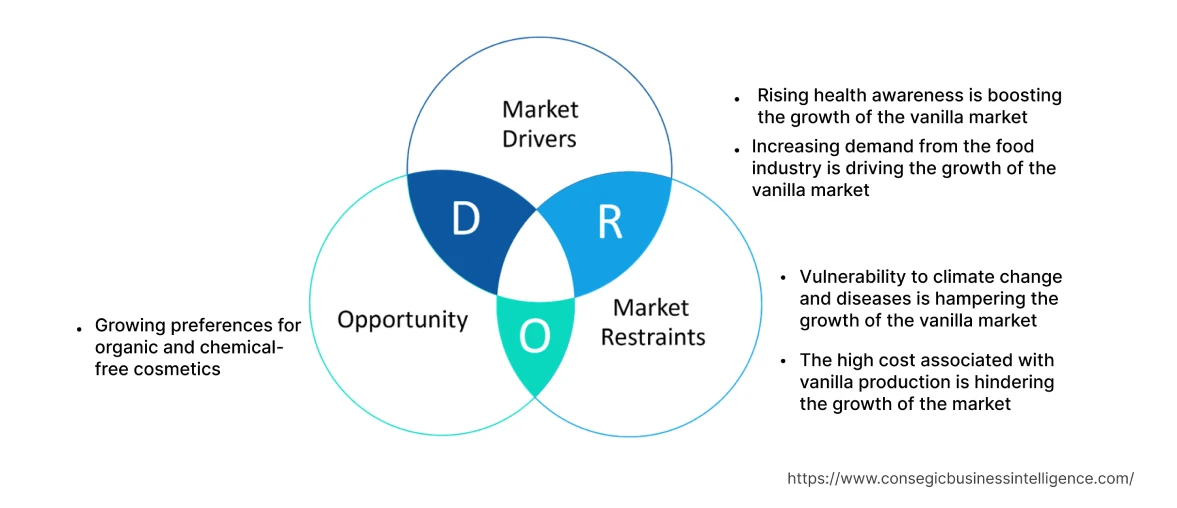Vanilla Market Size :
Consegic Business Intelligence analyzes that the Vanilla Market size is growing with a CAGR of 4.2% during the forecast period (2023-2030), and the market is projected to be valued at 3,151.76 Million by 2030 from 2,275.60 Million in 2022.
Vanilla Market Scope & Overview:
Vanilla is the fruit of an orchid plant, which grows in the form of a dark brown bean pod that is long and skinny. It is one of the most popular and widely used flavors in the world. As per the analysis, it is primarily grown in tropical regions such as Madagascar, Indonesia, and Mexico.
It is one of the most valuable spices also referred to as the queen of spices and is commonly used for its sweet flavor and floral scent in a wide range of food, beverage, and cosmetic products. Further, as per the analysis, it is increasingly used in cosmetic products that target sensitive or dry skin as well as in products intended for relaxation and stress relief.
As per the analysis, various types of this compound are commercialized in the market including Mexican, Madagascar, and Tahiti. The beans of Madagascar are considered the gold standard for quality beans in the spice world.
Vanilla Market Insights :
Key Drivers :
Rising health awareness is boosting the vanilla market growth
Vanilla is considered a natural and healthier alternative to artificial flavorings. Many consumers prioritize clean-label products and are conscious of the ingredients they consume. As per the analysis, it is a natural flavor derived from the vanilla orchid that offers properties such as anticancer, antidiabetic, antioxidant, antimicrobial, and anti-inflammatory making it an ideal choice for health-conscious individuals.
Additionally, as per the analysis, oil derived from this plant helps to lower blood pressure, improves muscle tension, and has a calming effect on the brain that helps in reducing stress and preventing insomnia and irritability.
For instance, according to the Observatory of Economic Complexity (OEC), vanilla is the world's most traded product, with a total trade of USD 936 million in 2020 which increased to USD 973 million in 2021. Hence, the rising health awareness is increasing the consumption of products derived from these plants which in turn is driving the market growth.
Increasing demand from the food sector is driving the expansion of the market
The food sector including bakeries, confectioneries, and dairy companies is a major driver of the market. Food sector widely involve the usage of this compound to enhance the flavor, taste, and aroma of food products. Further, as per the analysis, the increasing consumer preference for natural and high-quality flavors is surging the requirement for this compound as it is a natural flavor ingredient derived from pods of vanilla orchids.
It is a versatile flavor used in a wide range of products including ice cream, chocolate, desserts, and beverages, among others.
For instance, according to the India Brand Equity Foundation, in 2023, the food market in India is expected to generate revenue of USD 963 billion and is anticipated to expand at a CAGR of 7.23% by 2027. Hence, the expansion of the food sector is resulting in increased requirement for this substance as an essential ingredient which in turn is driving the vanilla market demand.
Key Restraints :
Vulnerability to climate change and diseases is hampering the expansion
Vanilla is a challenging crop to cultivate, and its production is limited to specific regions with the right climatic conditions. The majority of production originates from countries such as Madagascar, Indonesia, and Mexico. The cultivation is highly susceptible to climate change and various diseases such as vanilla wilt and black pod. Changes in weather patterns, such as droughts or excessive rainfall affect the expansion and yield of orchids. Thus, as per the analysis, the aforementioned environmental factors pose risks to the stability and availability of the supply which is the key factor hindering the expansion.
The high production cost is hindering the growth of the market
Vanilla is considered to be the second most expensive spice in the world after saffron. This is because the cultivation process of this compound is long and labor-intensive, particularly the hand-pollination process required for orchids of the compound. This manual process adds to the production costs. Further, skilled laborers are required for cultivation which adds to the labor cost. Thus, this high cost associated with this compound is likely to limit its adoption and hamper the trends of the market.
Future Opportunities :
Growing preferences for organic and chemical-free cosmetics
With the growing consumer preferences for natural and organic cosmetic products, the requirement for natural ingredients is expected to create lucrative vanilla market opportunities and trends in the coming years. Consumers are becoming more conscious of the ingredients they apply to their skin and seek products that are free from synthetic fragrances and potentially harmful chemicals. The compound is a natural fragrance ingredient that offers a warm and pleasant scent that can be used to add a sense of indulgence and relaxation in various personal care products such as perfumes, body lotions, and bath products, thereby, making it an ideal ingredient for cosmetic formulations.
For instance, according to the United Nations Industrial Development Organization, in Europe, the sales of natural and organic cosmetics over the past five years is increasing at an average of over 7% per year and is expected to reach USD 5.33 billion by 2023. Hence, the growing requirement for organic and chemical-free cosmetics is anticipated to increase the vanilla market trends.
Vanilla Market Report Insights :
| Report Attributes | Report Details |
| Study Timeline | 2017-2030 |
| Market Size in 2030 | USD 3,151.76 Million |
| CAGR (2023-2030) | 4.2% |
| By Product Type | Madagascar Vanilla, Mexican Vanilla, Tahitian Vanilla, and Others |
| By Type | Organic and Conventional |
| By Form | Powder, Liquid, and Others |
| By End-Use Industry | Food & Beverages, Pharmaceutical, Cosmetics & Personal Care, and Others |
| By Distribution Channel | Online (E-commerce Sites and Company Owned Websites) and Offline (Specialty Stores, Hypermarket/ Supermarket, and Others) |
| By Region | North America, Europe, Asia-Pacific, Latin America, Middle East & Africa |
| Key Players | Apex Flavors, Boston Vanilla Bean Company, Daintree Vanilla & Spice, E.A. Weber and Co., Lochhead Manufacturing Company, McCormick & Company, Inc., Nielsen-Massey Vanillas, Inc., Rodelle Inc., Sambirano Aromatic, Keliff's, and Blue Pacific Flavours |
| Geographies Covered | |
| North America | U.S. Canada Mexico |
| Europe | U.K. Germany France Spain Italy Russia Benelux Rest of Europe |
| APAC | China South Korea Japan India Australia ASEAN Rest of Asia-Pacific |
| Middle East and Africa | GCC Turkey South Africa Rest of MEA |
| LATAM | Brazil Argentina Chile Rest of LATAM |
| Report Coverage | Revenue Forecast, Competitive Landscape, Growth Factors, Restraint or Challenges, Opportunities, Environment & Regulatory Landscape, PESTLE Analysis, PORTER Analysis, Key Technology Landscape, Value Chain Analysis, Cost Analysis, and Regional Trends & Forecast |
Vanilla Market Segmental Analysis :
By Type :
The type segment is divided into organic and conventional. In 2022, the conventional segment accounted for the highest market revenue in the vanilla market as farming these beans by conventional means is cheaper and less cost-intensive as compared to the organic segment. The increasing consumer requirement for these products due to their pleasant flavor and the growing use of this compound extracts in various industries such as pharmaceuticals and food & beverage is driving the segment trends.
However, the organic segment is expected to grow at the fastest CAGR over the forecast period owing to growing consumer preferences towards the consumption of natural food products and flavors. Organic vanilla is free from synthetic pesticides, fertilizers, and herbicides. Further, the key market players are engaging in research and development activities to cater to the rising consumer demand for organically grown natural flavoring products.
For instance, in December 2021, Advanced Biotech introduced Abtvanforall plus natural, a bio-vanillin used in frozen dairy, alcoholic beverages, and baked goods. Hence, the introduction of such types of products is anticipated to drive the segment trends.
By Product Type :
The product type segment is categorized into Madagascar vanilla, Mexican Vanilla, Tahitian vanilla, and others. In 2022, the Madagascar vanilla segment accounted for the highest market vanilla market share of 38.95% in the overall vanilla market and is expected to grow at the fastest CAGR over the forecast period. Madagascar vanilla is also termed bourbon vanilla which originated from Madagascar region and has superior flavor and aromatic qualities as compared to other segments. Such type of vanilla has higher concentrations of vanillin that help to deliver rich, dark, and creamy flavors. Additionally, Madagascar vanilla is well suited for various baking recipes, drinks, and desserts which is a key factor contributing to the segment dominance.
For instance, according to the statistics published in Tridge, the Sava region is the largest producing area worldwide, with an estimated 70,000 smallholder farmers producing 80-90% of Madagascar or Bourbon vanilla on around 25,000 hectares of land. Approximately 10% of Madagascar's GDP comes from the vanilla industry which is the key factor boosting the segment trends.
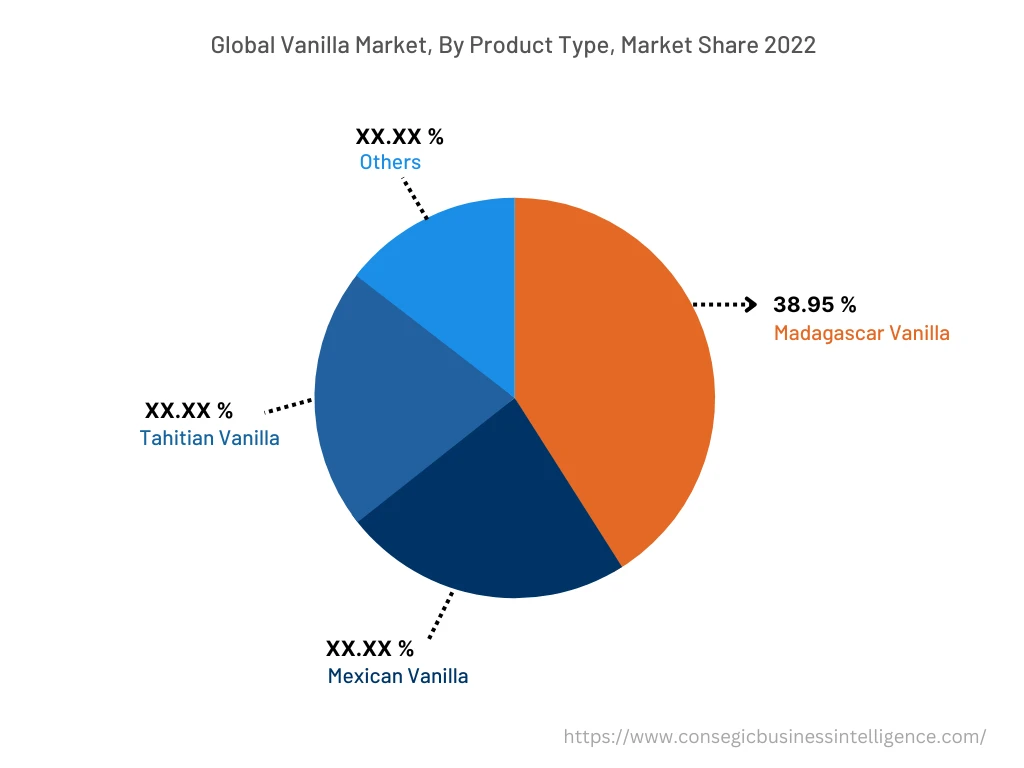
By Form :
The form segment is categorized into powder, liquid, and others. In 2022, the liquid accounted for the largest market revenue in the vanilla market and is anticipated to grow at the fastest CAGR over the forecast period. The liquid form involves extract which is a popular flavor additive used in culinary preparations and has a longer shelf life and stability as compared to other forms. Liquid form is widely used in both sweet and savory dishes including baked goods, desserts, beverages, and sauces. Further, many key players are involved in the development of new extracts to cater to the growing demand of end-users.
For instance, Nielsen-Massey Vanillas introduced two new single-origin pure extracts from Uganda and Indonesia for a wide variety of baking and cooking applications. Hence, the availability of such a wide range of extracts is a crucial factor contributing to segment dominance.
By Distribution Channel :
The distribution channel is divided into online and offline. In 2022, the offline segment accounted for the highest market share in the vanilla market as extracts or beans are available in a wide range of stores including hypermarket/supermarket, retail shops, specialty stores, and others. Customers exhibit a preference for physical product testing before the purchase of food products or food additives such as syrups and powders to inspect the product expiry date, manufacturing date, and others. Therefore, offline stores provide the opportunities to understand product composition, properties, and functionality, resulting in the expansion of the offline segment.
However, the online segment is expected to emerge as the fastest-growing segment during the forecast period. The developemnt of this segment is attributed to the shift in customer behavior of shopping online through e-commerce websites and company-owned websites. Online sales channel provides opportunities for customers to compare the prices of different products before purchasing. Furthermore, the facility of home delivery provided by online sales channels is contributing to the growth of the vanilla market.
By End-Use-Industry :
The end-use industry segment is classified into food & beverages, pharmaceutical, cosmetics & personal care, and others. In 2022, the food and beverage segment accounted for the highest market share in the vanilla market due to the widespread use of these extract as a flavoring agent in dairy products, baked goods, beverages, and confections. Vanillin or these flavors are extensively used in many alcoholic beverages such as cocktails, whiskeys, and cordials to enhance the taste of the drinks. Further, vanilla-flavored foaming creamers are widely commercialized in the market due to their growing use as coffee or tea additive to create a creamy and foamy texture.
For instance, Larid Superfood, a superfood products manufacturer company introduced the launch of Vanilla Superfood Creamer. The product is produced using Madagascar bourbon vanilla, creamy coconut, cinnamon, and maple sugar. Hence, the introduction of such types of new products by the key players aids in expanding the vanilla market trends.
However, the cosmetics & personal care segment is anticipated to grow at the fastest CAGR over the forecast period. The extracts contain specific antioxidants that help to heal damaged skin and reduce wrinkles and provide a soothing fragrance. Further, the fragrance has a calming effect and plays a crucial role in reducing startle reflexes, and also provides relief from sleep apnea. Hence, the increasing use of this compound in cosmetics and personal care products due to the aforementioned properties is anticipated to boost market trends.
By Region :
The regional segment includes North America, Europe, Asia Pacific, the Middle East and Africa, and Latin America.
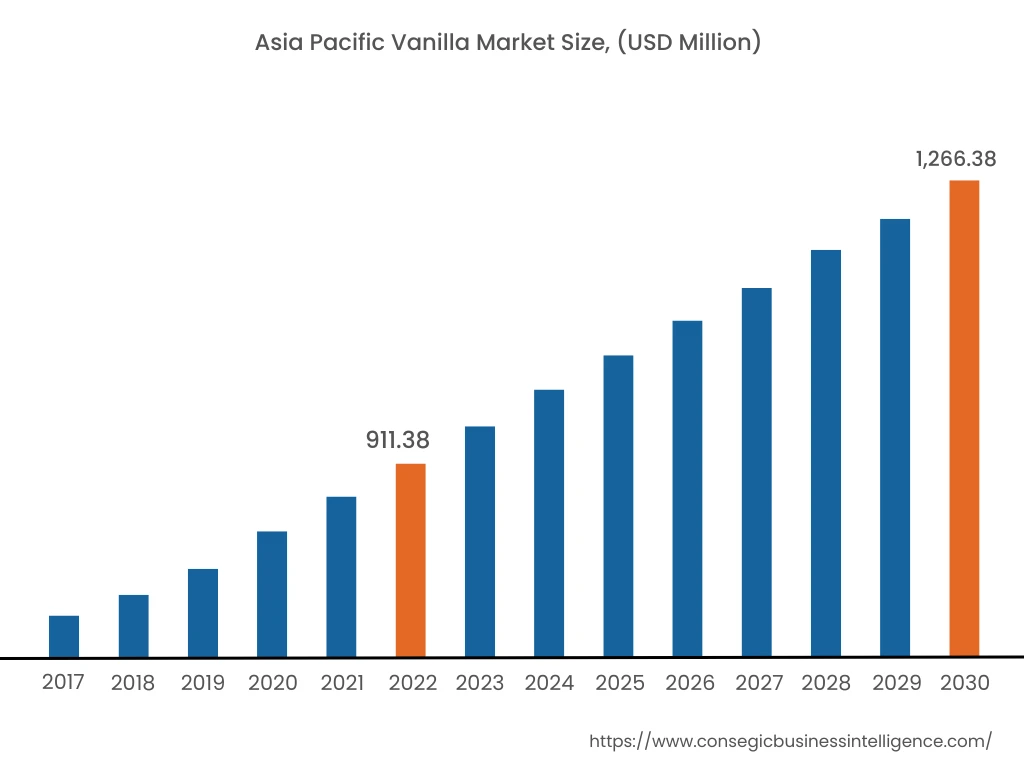
In 2022, Asia Pacific accounted for the highest market share at 40.05% and was valued at USD 911.38 million, and is expected to reach USD 1,266.38 million in 2030. In Asia Pacific, China accounted for the highest market share of 33.35% during the base year 2022. Based on the vanilla market analysis, the growth is attributed to the increasing development of the food & beverage sector particularly in India and China which requires the use of this compound as a flavoring agent in various food products including cakes, cookies, pastries, ice creams, desserts, and other savory dishes. Hence, the above-mentioned factor is responsible for boosting the growth of the vanilla market in the region.
However, Europe is expected to grow at the fastest CAGR of 5.3% over the forecast period in the market owing to the increasing demand for natural products and the higher consumption of processed foods, such as chocolate, ice cream, and bakery products in the region.
Additionally, the European food and drink sector is one of the largest in the world. For instance, according to the data published in FoodDrinkEurope, in 2022, the food and drink sector of Europe generated a turnover of approximately USD 1.17 trillion. Hence, this increasing growth of the food and drinks sector is boosting the need for flavoring agents which is anticipated to drive the growth of the vanilla market over the forecast period.
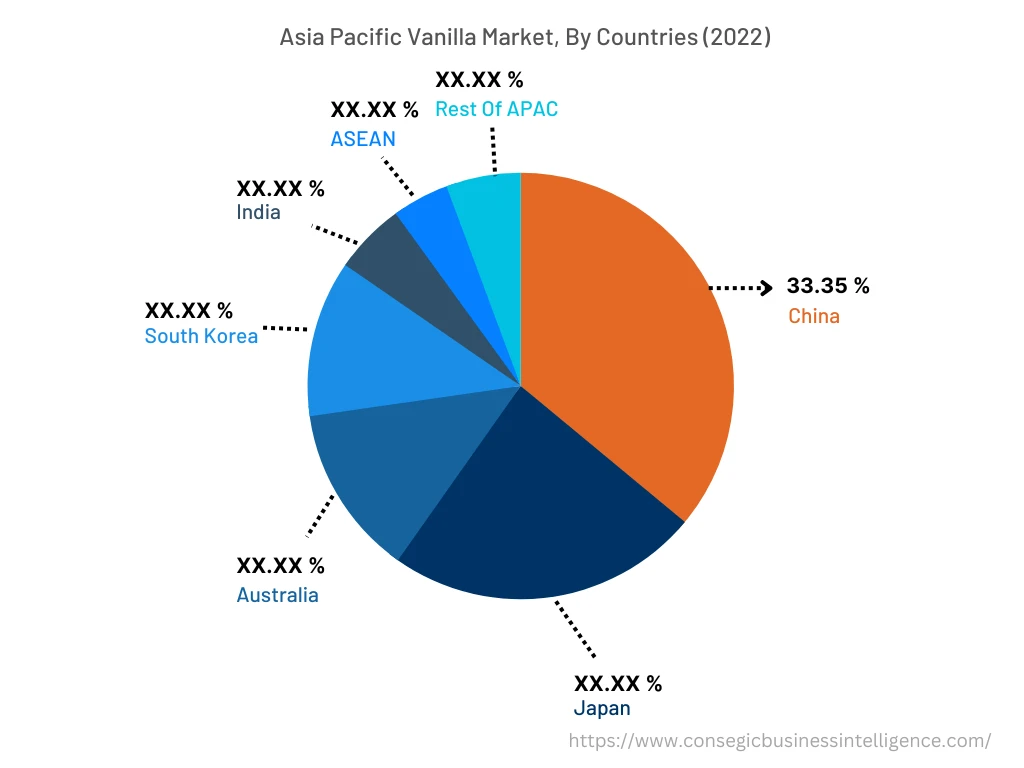
Top Key Players & Market Share Insights:
The global vanilla market is highly competitive, with several large players and numerous small and medium-sized enterprises. These companies have strong research and development capabilities and a strong presence in the market through their extensive product portfolios and distribution networks. The market is characterized by intense competition, with companies focusing on expanding their product offerings and increasing their market share through mergers, acquisitions, and partnerships. The key players in the market include-
- Apex Flavors
- Boston Vanilla Bean Company
- Rodelle Inc.
- Sambirano Aromatic
- Keliff's
- Blue Pacific Flavours
- Daintree Vanilla & Spice
- E.A. Weber and Co.
- Lochhead Manufacturing Company
- McCormick & Company, Inc.
- Nielsen-Massey Vanillas, Inc.
Recent Industry Developments :
- In January 2021, Blue Pacific Flavours, the U.S.-based company launched a sustainable vanilla extract called Kilimanjaro Vanilla aimed to meet consumer demand for natural, clean-label, and sustainably produced products.
- In January 2020, Nielsen-Massey Vanillas, Inc., the manufacturer of premium, pure vanilla extracts introduced new 2-ounce bottles of its popular Madagascar Bourbon Pure Vanilla Bean Paste and Pure Vanilla Bean Paste.
Key Questions Answered in the Report
What was the market size of the vanilla market in 2022? +
In 2022, the market size of vanilla was USD 2,275.60 million
What will be the potential market valuation for the vanilla market by 2030? +
In 2030, the market size of vanilla will be expected to reach USD 3,151.76 million.
What are the key factors driving the growth of the vanilla market? +
Rising health awareness and increasing demand from the food industry are the key factors driving the growth of the vanilla market.
What is the dominating segment in the vanilla market, by product type? +
In 2022, the Madagascar vanilla segment accounted for the highest market share of 38.95% in the overall vanilla market.
Based on current market trends and future predictions, which geographical region will have the fastest impact on the vanilla market's growth in the coming years? +
Europe is expected to be the fastest-growing region in the market during the forecast period.
